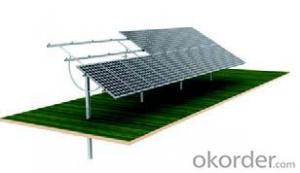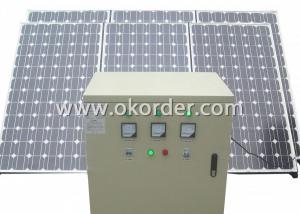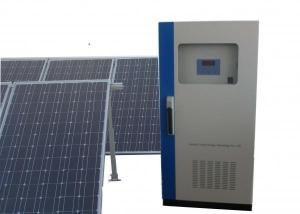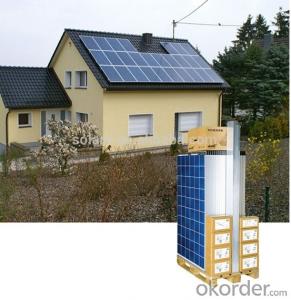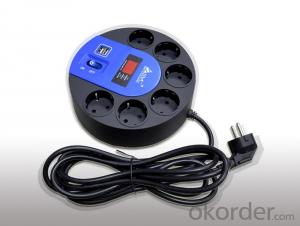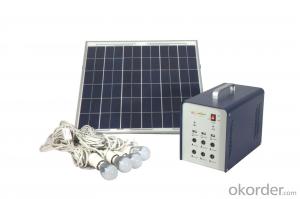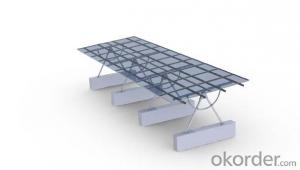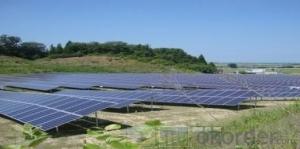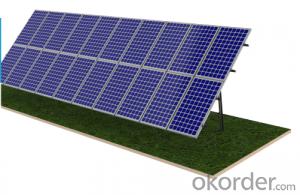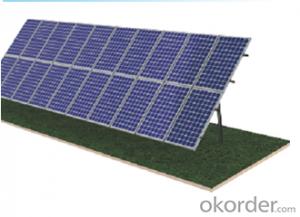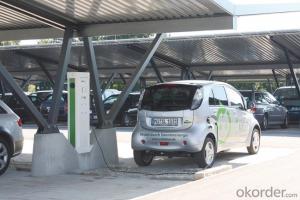Solar Energy Systems Lancaster Single Pile Manual Solar Mounting System
- Loading Port:
- China Main Port
- Payment Terms:
- TT OR LC
- Min Order Qty:
- -
- Supply Capability:
- -
OKorder Service Pledge
OKorder Financial Service
You Might Also Like
Packaging & Delivery
Packaging Detail:Normal package seaworthy
Delivery Detail:15 days
Specifications
Easy installation Competitive price TUV&SGS test report & CSA certification 15-warranty
Specifications
1) Super smooth beautiful appearance,outstanding quality,large supply.
2) Available in customized surface finishes.
3) Well machined,for example,cutting,drilling and milling with excellent tolerance.
4) Meet with customer’s designs and supply you best price.
5)Usages:Supply for solar panel modules.
Technical characteristics
Installation site:
ground,hillside,and grassland
Installation angle
it is based on customers’ requirements
Installation height
it is basedon customers’ requirements
Solar panel type; with or without frame
Components arrangement :horizontal or vertical
Support track
aluminum alloy extrusion
Quality warranty
15 years
Advantages
1)Quick installation: with high degree of pre-installed rate, the system could be easily installed by using galvanized carbon steel rails for PV Stent, and specially designed connection parts of the PV bracket, which could reduce installation time and cost greatly.
2)Offer unmatched durability: with all structural components comprised of high class stainless steel and anodized aluminum alloy, it is designed for 25 years service life and backed by 15 years warranty.
3)Stand up to extreme weather: The SuninTek solar mount is designed to stand up to the extreme weather complied with the AS/NZ 1170 and other international structure load standard by the skilled engineer. The main support components also have been tested to guarantee its structure and load-carrying capacity.
4)Provide broad installation flexibility: These systems accommodate most commercially available framed solar panels , and they can scale easily from small to large, multi-megawatt installations.
5)Diversified Application: The PV mounting system produced can be adopted by various types of PV cells panels which you can find in the market. It can serve for both mini solar power system and huge plant with megawatt capability.
Main features
1. Installation cost savings.
2. Save installation time.
3. Increase the mechanical strength of solar energy mounting to ensure that wind requirements.
4. The outdoor for installation of solar energy.
5. Length can be customized according to customers.
6. Service life of up to 25 years.
7. Products through the international certification.
8. Stent material composition of the galvanized steel and aluminum.
9. 15 years system and structural guarantee.
10.Flexible post spacing withstands different wind & snow loads.
11. High quality material in Aluminium 6005-T5 and SUS 304.
12.Screws and nuts go with every components needed.
13.Mechanical calculation and reliability tested to ensure highest product quality.
- Q: Can solar energy systems be used in powering art galleries or museums?
- Yes, solar energy systems can indeed be used to power art galleries or museums. Solar panels can be installed on the rooftops or surrounding areas of these buildings to capture sunlight and convert it into electricity. This renewable energy source can provide a sustainable and cost-effective solution for powering lighting, climate control systems, and other electrical needs within art galleries and museums. Additionally, using solar energy can contribute to reducing the carbon footprint of these institutions, making them more environmentally friendly.
- Q: How does the cost of solar energy compare to other energy sources?
- Over the past few years, solar energy has become increasingly cost competitive with other forms of energy. In the beginning, solar panels were more expensive due to high installation costs and limited efficiency compared to fossil fuels. However, advancements in technology, economies of scale, and supportive government policies have significantly reduced the cost of solar energy. Currently, solar energy is rapidly becoming more affordable and competitive. In many areas, it is already cheaper than coal and natural gas, which used to be the most cost-effective energy sources. This trend is expected to continue as solar technology improves and becomes more efficient. One of the main reasons for the decrease in solar energy costs is the falling prices of solar panels. Over time, the prices of photovoltaic (PV) modules, the key component of solar panels, have significantly dropped. Additionally, the manufacturing process has become more streamlined and efficient, resulting in cost savings. Moreover, the operational costs of solar energy are relatively low because sunlight, the primary fuel source, is abundant and free. Compared to fossil fuel-based power plants, solar energy systems require less maintenance and have a longer lifespan, leading to lower operating costs in the long run. Government incentives and policies have also played a crucial role in reducing the cost of solar energy. Many countries and regions offer financial incentives, tax credits, grants, and subsidies to encourage the use of solar energy. These initiatives make solar installations more affordable for consumers and incentivize investment in solar technology, driving economies of scale and further reducing costs. In conclusion, the cost of solar energy has become highly competitive with other energy sources due to technological advancements, economies of scale, and supportive government policies. As solar energy becomes more affordable, it is expected to play a significant role in the global energy transition, offering a clean, sustainable, and cost-effective alternative to traditional energy sources.
- Q: Are there any limitations to using solar energy systems?
- Yes, there are limitations to using solar energy systems. One limitation is their dependence on sunlight, which means they are less effective in areas with frequent cloudy weather or limited sunlight. Additionally, the initial cost of installing solar panels can be high, although the long-term savings on energy bills can offset this. Lastly, the amount of energy generated by solar systems may fluctuate depending on the time of day and season, requiring backup energy sources or energy storage systems.
- Q: Can solar energy systems be used in areas with limited access to housing?
- Yes, solar energy systems can be used in areas with limited access to housing. In fact, solar energy can be particularly beneficial in such areas as it offers an independent and decentralized source of power. Solar panels can be installed on rooftops, open spaces, or even mounted on portable structures, making it feasible to generate electricity in remote or off-grid locations. Additionally, advancements in solar technology, such as smaller and more efficient panels, have made it easier to implement solar energy systems in areas with limited housing infrastructure.
- Q: How do solar energy systems impact the quality of air and water?
- The quality of air and water is positively affected by solar energy systems. Unlike coal or gas, which are traditional energy sources, solar energy does not release harmful emissions or pollutants, resulting in a significant decrease in air pollution. This not only enhances air quality but also aids in reducing the greenhouse gas emissions that contribute to climate change. Solar energy systems also have a minimal impact on water quality. Although some water is utilized during the manufacturing process of solar panels, the quantity used is considerably lower compared to other energy sources like fossil fuels. Furthermore, solar energy does not require water for its operation, unlike thermal power plants that consume large amounts of water for cooling purposes. Additionally, the use of solar energy diminishes reliance on fossil fuels, which are often obtained through environmentally destructive methods such as fracking or oil spills. Shifting to solar energy significantly reduces the risk of water contamination resulting from these activities. Moreover, solar energy systems contribute to the conservation of water resources. Traditional energy sources like coal or gas power plants necessitate substantial amounts of water for operation, which can strain local water supplies and ecosystems. On the other hand, solar energy generation does not require water, thus aiding in the conservation of water resources and alleviating stress on aquatic ecosystems. In conclusion, solar energy systems have a positive impact on both air and water quality. They aid in reducing air pollution, greenhouse gas emissions, and the risk of water contamination, while also conserving water resources. By embracing solar energy, we can advocate for a cleaner and healthier environment for future generations.
- Q: Can a solar energy system be installed on a commercial parking lot?
- Yes, a solar energy system can be installed on a commercial parking lot. Commercial parking lots often have ample space for solar panels to be installed on canopies or mounted on structures like carports. This allows for the generation of clean and renewable energy while also providing shade and protection for vehicles. Additionally, commercial parking lots are typically well-suited for solar installations due to their large surface areas and accessibility to sunlight.
- Q: Can solar energy systems be used in areas with limited access to training programs?
- Yes, solar energy systems can be used in areas with limited access to training programs. While training programs can provide valuable knowledge and skills in installing and maintaining solar energy systems, there are alternative resources available. Online courses, instructional videos, and manuals can offer self-learning opportunities for individuals in areas with limited access to training programs. Additionally, local technicians with expertise in solar energy can be trained to support the installation and maintenance of these systems, ensuring the utilization of solar energy even in areas with limited training resources.
- Q: Are there any risks of electrical hazards during installation or maintenance of solar energy systems?
- During the installation or maintenance of solar energy systems, there are indeed risks of electrical hazards. Working with high-voltage DC electricity in solar energy systems can be dangerous if not handled correctly. Here are some potential risks to be aware of: 1. Electrocution: Incorrect isolation or disconnection of solar panels can lead to electrocution for those working on the system. 2. Fire Hazards: Faulty wiring, loose connections, or improper installation can cause electrical arcs and sparks, potentially resulting in a fire if proper precautions are not taken. 3. Falls and Injuries: Installing solar panels on rooftops involves climbing ladders, working at heights, and handling heavy equipment. Carelessness can lead to slips, falls, and injuries. 4. Arc Flash: Working on live electrical equipment poses a risk of sudden energy release, known as arc flash. This can cause severe burns, hearing damage, and even death. 5. Environmental Risks: Although not directly related to electrical hazards, it is essential to consider environmental risks during solar energy system installation. Improper disposal of hazardous materials used in solar panels, such as lead, cadmium, or other toxic substances, can harm the environment if not handled correctly. To reduce these risks, it is crucial to follow proper safety protocols and guidelines during installation and maintenance. This includes wearing personal protective equipment (PPE), following grounding and isolation procedures, using insulated tools, and adhering to local electrical codes and regulations. Hiring trained and certified professionals for installation and maintenance is also recommended to minimize the risks associated with electrical hazards.
- Q: Can a solar energy system be used in areas prone to hurricanes or tornadoes?
- Yes, a solar energy system can be used in areas prone to hurricanes or tornadoes. While it is true that these natural disasters can cause damage to solar panels and other components of the system, proper planning and installation can mitigate the risks. One key consideration is the design and structural integrity of the solar panels themselves. High-quality solar panels are built to withstand strong winds and extreme weather conditions. They are usually tested and certified to meet specific standards, including wind resistance ratings. In areas prone to hurricanes or tornadoes, it is important to install solar panels that are specifically designed to withstand the potential wind speeds and impacts associated with these events. Additionally, proper installation techniques can enhance the resilience of a solar energy system. For example, using reinforced mounting structures, securing panels with additional brackets or fasteners, and ensuring secure connections between panels, inverters, and batteries can help prevent damage caused by strong winds or flying debris. In some cases, homeowners may also choose to invest in solar panel tracking systems that allow the panels to automatically adjust their position to reduce wind resistance during extreme weather events. This feature can help protect the panels and increase their chances of surviving a hurricane or tornado with minimal damage. Furthermore, it is essential to have a backup power storage system in place, such as batteries, to ensure continuous power supply during and after a severe weather event. This backup system can store excess energy generated by the solar panels, allowing the system to operate independently of the grid during power outages caused by hurricanes or tornadoes. Overall, while there are risks associated with using a solar energy system in areas prone to hurricanes or tornadoes, careful planning, proper installation, and the use of resilient components can make it possible to harness solar power even in these challenging environments.
- Q: Can solar energy systems be installed in areas with high snowfall?
- Yes, solar energy systems can be installed in areas with high snowfall. However, it is important to consider the impact of snow accumulation on the efficiency and performance of these systems. Proper design and installation techniques can help minimize the impact of snow on solar panels, such as tilted mounting angles, snow guards, and regular snow removal. Additionally, advancements in technology have led to the development of snow-shedding coatings and self-cleaning systems that can further enhance the productivity of solar energy systems in snowy regions.
Send your message to us
Solar Energy Systems Lancaster Single Pile Manual Solar Mounting System
- Loading Port:
- China Main Port
- Payment Terms:
- TT OR LC
- Min Order Qty:
- -
- Supply Capability:
- -
OKorder Service Pledge
OKorder Financial Service
Similar products
Hot products
Hot Searches
Related keywords
